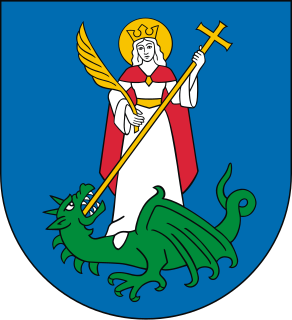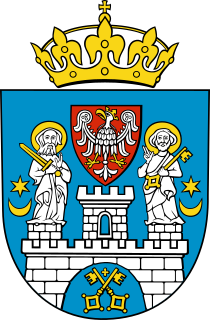 W
WThe coat of arms of Bytom in Silesia, Poland, was adopted in 1886 by a resolution of the town council.
 W
WThe coat of arms of the city of Gdańsk, in its current form, dates back to 1410 and Banderia Prutenorum. The coat of arms is very similar to the flag of Gdańsk. It depicts two silver crosses on a red shield above each other, above which hovers a golden crown. The greater arms also has two lions as supporters and Gdańsk motto.
 W
WThe coat of arms of Głogów depicts a shield divided crosswise into four fields, with a fifth central field on which there appears in the centre an initial golden "G" on a red background.
 W
WThe coat of arms of Kłodzko shows a white Bohemian Lion on a red field with a golden crown and a double tail. The coat of arms comes from the dynasty of Czech kings Premyslids.
 W
WThe city of Kraków uses a coat of arms, a seal, official colors, a flag, and a banner as its official symbols. Additionally, a number of semi-official and unofficial symbols of the city are also used.
 W
WThe coat of arms of Kurów and the Kurów municipality consists of a white cock with a gold crest, bill, talons and in its beak a white handkerchief in a red field.
 W
WThe coat of arms of Lubawa in the Warmian-Masurian Voivodeship, Poland, depicts a bishop of Chełmno or Culm, generally identified as the first bishop, Christian of Oliva, with his right hand raised in benediction. He stands between a lime tree and a fir tree.
 W
WThe Lublin coat of arms is one of the city symbols of Lublin, Poland. The coat of arms was established by the Lublin City Council on 8 July 2004.
 W
WThe coat of arms of Nowy Sącz in Poland shows Saint Margaret the Virgin, depicting the legend that she was swallowed by Satan, in the form of a dragon, who was however forced to spit her out again because the cross she was carrying irritated the dragon's innards. In Margaret's other hand is an olive branch, a symbol of peace.
 W
WThe coat of arms of Nowy Targ, a town in southern Poland, depicts the martyr Saint Catherine of Alexandria dressed in white with a red cape with white stars, wearing a gold crown. She holds a sword at her side and a palm leaf. She stands in front of a gold Catherine wheel. Her head is encircled by a halo, indicating her sainthood.
 W
WThe coat of arms of the Polish city of Piła features a red deer on a green field, leaping to the dexter. It was first featured on a seal of the city council created probably in 1571. Initially, the deer was leaping towards the sinister side of the shield; this was changed in the 17th century. During the Partitions of Poland the local German authorities sometimes also used a modification of the coat of arms featuring a crowned deer.
 W
WThe coat of arms of Poznań consists of white city walls with three towers. On the left (heraldic) tower stands Saint Peter with a key and on the heraldic right one stands Saint Paul with a sword. In the gate there are two golden crossed keys with a cross above. Over the middle tower, which contains a single window and is topped by a battlement, there is a gothic shield with a white eagle in crown. On the sides of the two saints there are golden crescents and stars. All of those elements are on a blue field. Over the shield there is golden crown. Author of modern version of coat of arms is Jerzy Bąk.
 W
WThe coat of arms of the city of Rybnik in Poland consists of a blue shield bearing a white pike rising diagonally between two floral patterns. The arms are an example of canting arms, since ryb means "fish". This coat was adopted by the Rybnik City Council on November 20, 2000.
 W
WThe coat of arms of Słupsk shows the red griffin of the Duchy of Pomerania above a stylised representation of three waves, indicating the three streams of the Słupia River as it flows through Słupsk. The city has used this device or a variant of it since the 14th century.
 W
WThe coat of arms that serves as a symbol of the city of Szczecin in West Pomeranian Voivodeship, Poland.
 W
WThe original coat of arms of Ustka, Poland was created in 1922 by local artist Wilhelm Granzow.
 W
WThe coat of arms of Warsaw consists of a syrenka in a red field. This imagery has been in use since at least the mid-14th century. The syrenka has traditionally held a silver sword although this does not appear on more recent versions.
 W
WThe coat of arms of the City of Wrocław is divided into quarters. It dates back to 1530, when it was approved by Emperor Charles V.